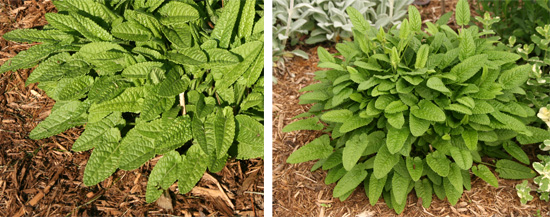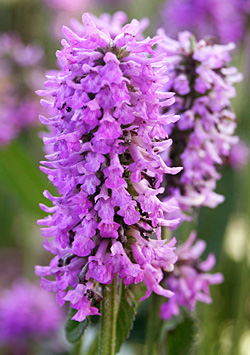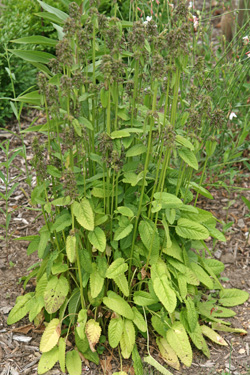
With dark green leaves and bright purple-pink flowers, the distinctive Stachys cultivar ‘Hummelo’ (named in honor of a district in The Netherlands) makes a splash in any garden. There is considerable confusion about the nomenclature of this herbaceous perennial in the mint family (Lamiaceae). It is variously listed as S. densiflora, S. monnieri, and S. officinalis.

Regardless of its true identity, this cultivar hardy in zones 4-8 is easy to grow and deserves to be planted more widely. It was the highest rated of 22 Stachys in the Plant Evaluation Trials at the Chicago Botanic Garden from 1998-2004 for its strong flower production, vigor, habit quality and winter hardiness.
Very different in appearance from its fuzzy-leaved relative S. byzantina (lamb’s ears), ‘Hummelo’ has glossy, dark green leaves. Each 4-6″ ovate leaf is wrinkled or puckered with tightly scalloped edges and a rounded tip. The 10-12″ high basal rosettes of foliage that are produced in spring remain fresh-looking until fall. Although it is evergreen in mild climates, in colder zones the leaves die back completely over the winter. Clumps very gradually expand outward as stolons creep away from the plant and root at the ground surface.

This low-growing plant offers a vertical, spiky appearance when in bloom with numerous leafless, erect flower spikes up to 2 feet tall, rising well above the leaves.

Each dense flower spike is crowded with tiny, two-lipped flowers. The flowers are a rose-lavender color and are attractive to bees, butterflies and hummingbirds. Plants are in bloom for a relatively long time in mid-summer and superficially resemble some of the salvias.

The flower spikes can be deadheaded for a tidier appearance and possible second flush of bloom or left standing for winter interest.
Grow ‘Hummelo’ in well-drained soil. It prefers full sun but will tolerate partial shade. Place plants 12-18″ apart. Keep well watered, as it does not tolerate drought well. It has few pests and is not favored by deer or rabbits. Propagate by division in spring or fall.

Use ‘Hummelo’ in beds and borders, as a specimen in a rock garden, or massed as a ground cover. Being relatively short and dense it can make a good edging plant. Combine it with other perennials such as true geraniums, Shasta daisies (Leucanthemum), and ornamental grasses. It can also be grown in containers (but those would need protection in harsh winter climates).
– Susan Mahr, University of Wisconsin – Madison
Ask Your Gardening Question
If you’re unable to find the information you need, please submit your gardening question here:





 ▶︎ Watch: Fall Bulb Planting
▶︎ Watch: Fall Bulb Planting Aster, Symphyotrichum spp.
Aster, Symphyotrichum spp. Fascinating Fasciation
Fascinating Fasciation Alternatives to Lawn: Groundcovers
Alternatives to Lawn: Groundcovers


